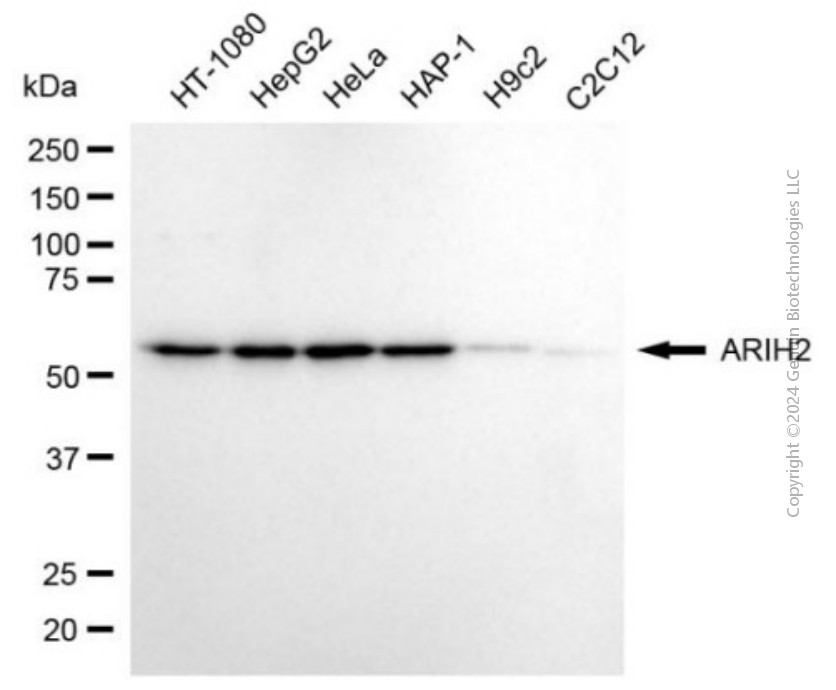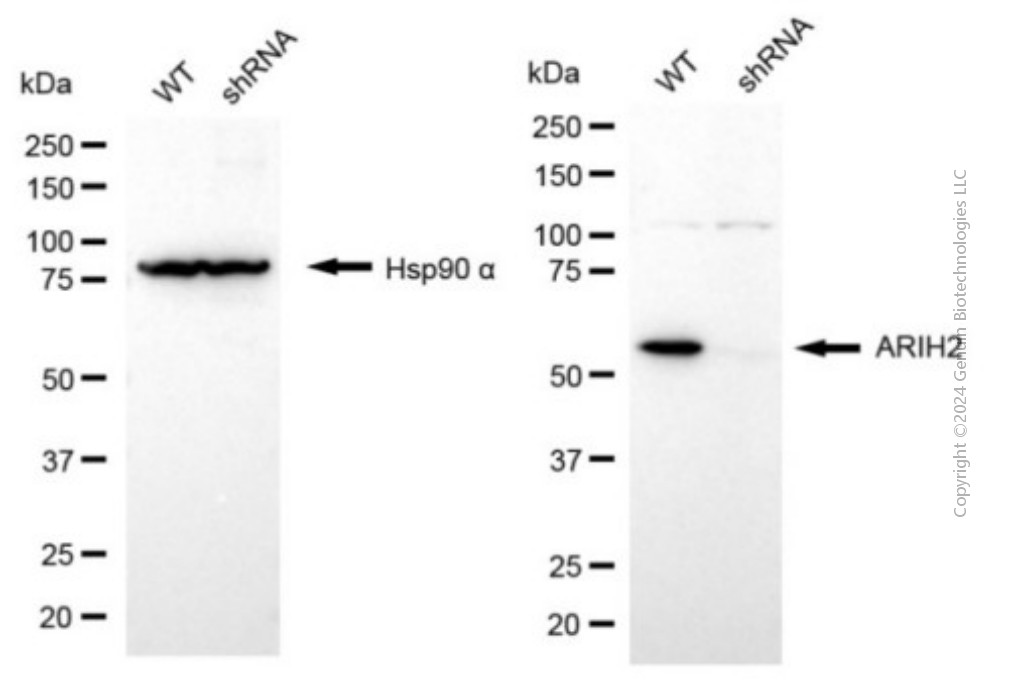KD-Validated Anti-Purified ARIH2 Mouse Monoclonal Antibody
Mouse monoclonal antibody
- SPECIFICATION
- CITATIONS
- PROTOCOLS
- BACKGROUND

Application
| WB |
|---|---|
| Primary Accession | O95376 |
| Reactivity | Rat, Human, Mouse |
| Clonality | Monoclonal |
| Isotype | Mouse IgG1 |
| Clone Names | 24GB8000 |
| Calculated MW | Predicted, 58 kDa, observed, 58 kDa |
| Gene Name | ARIH2 |
| Aliases | ARIH2; Ariadne RBR E3 Ubiquitin Protein Ligase 2; TRIAD1; All-Trans Retinoic Acid Inducible RING Finger; RING-Type E3 Ubiquitin Transferase ARIH2; E3 Ubiquitin-Protein Ligase ARIH2; Protein Ariadne-2 Homolog; ARI2; Ariadne (Drosophila) Homolog 2; Ariadne Homolog 2 (Drosophila); Ariadne Homolog 2; Triad1 Protein; EC 2.3.2.31; ARI-2 |
| Immunogen | Recombinant protein of human ARIH2 |
| Gene ID | 10425 |
|---|---|
| Other Names | E3 ubiquitin-protein ligase ARIH2, ARI-2, Protein ariadne-2 homolog, 2.3.2.31, Triad1 protein, ARIH2 {ECO:0000303|PubMed:31253590, ECO:0000312|HGNC:HGNC:690} |
| Name | ARIH2 {ECO:0000303|PubMed:31253590, ECO:0000312|HGNC:HGNC:690} |
|---|---|
| Function | E3 ubiquitin-protein ligase, which catalyzes ubiquitination of target proteins together with ubiquitin-conjugating enzyme E2 UBE2L3 (PubMed:16118314, PubMed:17646546, PubMed:19340006, PubMed:24076655, PubMed:33268465, PubMed:34518685, PubMed:38418882). Acts as an atypical E3 ubiquitin-protein ligase by working together with cullin-5-RING ubiquitin ligase complex (ECS complex, also named CRL5 complex) and initiating ubiquitination of ECS substrates: associates with ECS complex and specifically mediates addition of the first ubiquitin on ECS targets (PubMed:33268465, PubMed:34518685, PubMed:38418882). The initial ubiquitin is then elongated (PubMed:33268465). E3 ubiquitin- protein ligase activity is activated upon binding to neddylated form of the cullin-5 (CUL5) component of the ECS complex (PubMed:24076655). Together with the ECS(ASB9) complex, catalyzes ubiquitination of CKB (PubMed:33268465). Promotes ubiquitination of DCUN1D1 (PubMed:30587576). Mediates 'Lys-6', 'Lys-48'- and 'Lys-63'-linked polyubiquitination (PubMed:16118314, PubMed:17646546, PubMed:19340006). May play a role in myelopoiesis (PubMed:19340006). |
| Cellular Location | Nucleus. Cytoplasm |
| Tissue Location | Widely expressed with higher expression in granulocytes. |

Thousands of laboratories across the world have published research that depended on the performance of antibodies from Abcepta to advance their research. Check out links to articles that cite our products in major peer-reviewed journals, organized by research category.
info@abcepta.com, and receive a free "I Love Antibodies" mug.
Provided below are standard protocols that you may find useful for product applications.
If you have used an Abcepta product and would like to share how it has performed, please click on the "Submit Review" button and provide the requested information. Our staff will examine and post your review and contact you if needed.
If you have any additional inquiries please email technical services at tech@abcepta.com.














 Foundational characteristics of cancer include proliferation, angiogenesis, migration, evasion of apoptosis, and cellular immortality. Find key markers for these cellular processes and antibodies to detect them.
Foundational characteristics of cancer include proliferation, angiogenesis, migration, evasion of apoptosis, and cellular immortality. Find key markers for these cellular processes and antibodies to detect them. The SUMOplot™ Analysis Program predicts and scores sumoylation sites in your protein. SUMOylation is a post-translational modification involved in various cellular processes, such as nuclear-cytosolic transport, transcriptional regulation, apoptosis, protein stability, response to stress, and progression through the cell cycle.
The SUMOplot™ Analysis Program predicts and scores sumoylation sites in your protein. SUMOylation is a post-translational modification involved in various cellular processes, such as nuclear-cytosolic transport, transcriptional regulation, apoptosis, protein stability, response to stress, and progression through the cell cycle. The Autophagy Receptor Motif Plotter predicts and scores autophagy receptor binding sites in your protein. Identifying proteins connected to this pathway is critical to understanding the role of autophagy in physiological as well as pathological processes such as development, differentiation, neurodegenerative diseases, stress, infection, and cancer.
The Autophagy Receptor Motif Plotter predicts and scores autophagy receptor binding sites in your protein. Identifying proteins connected to this pathway is critical to understanding the role of autophagy in physiological as well as pathological processes such as development, differentiation, neurodegenerative diseases, stress, infection, and cancer.



